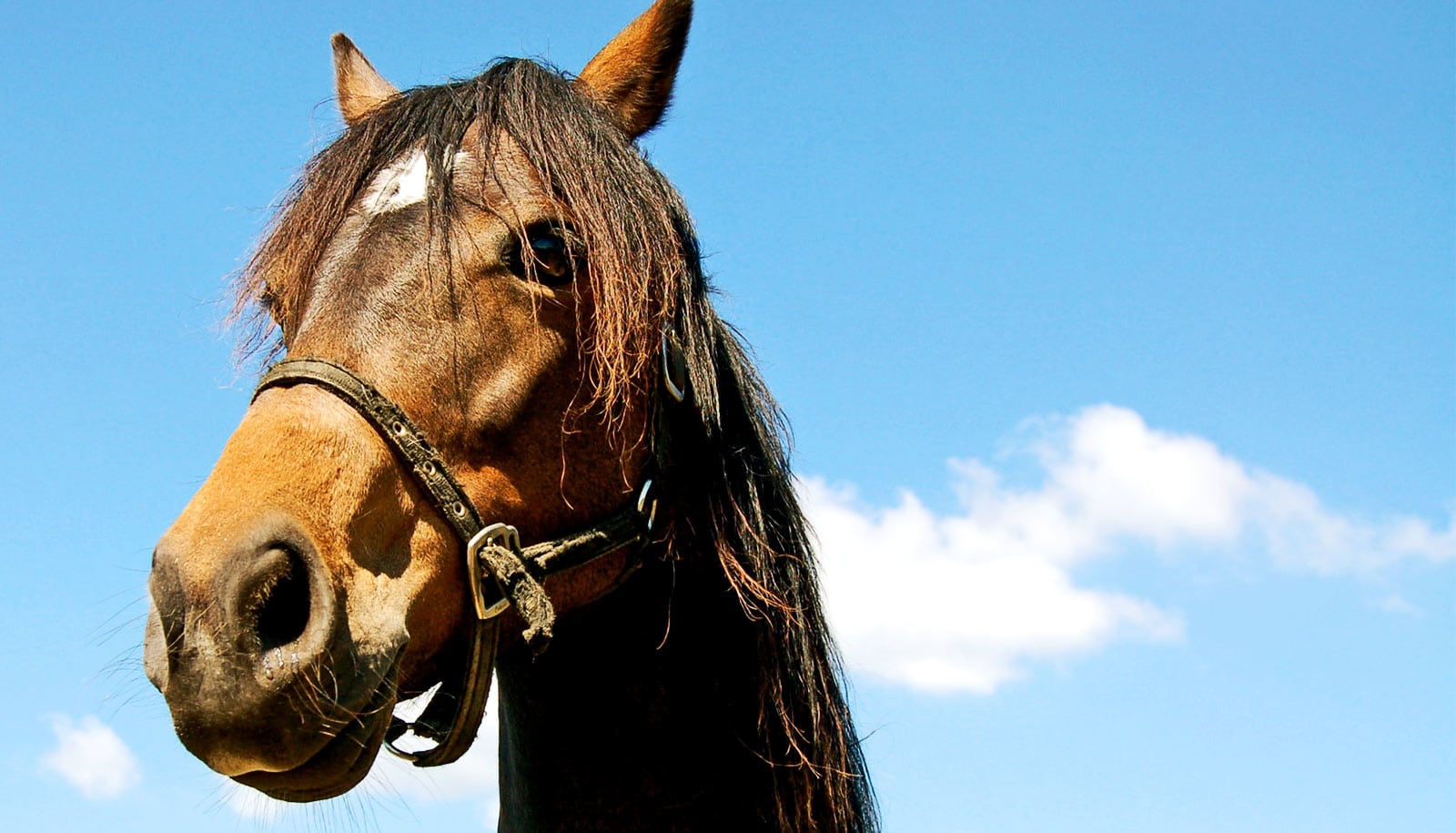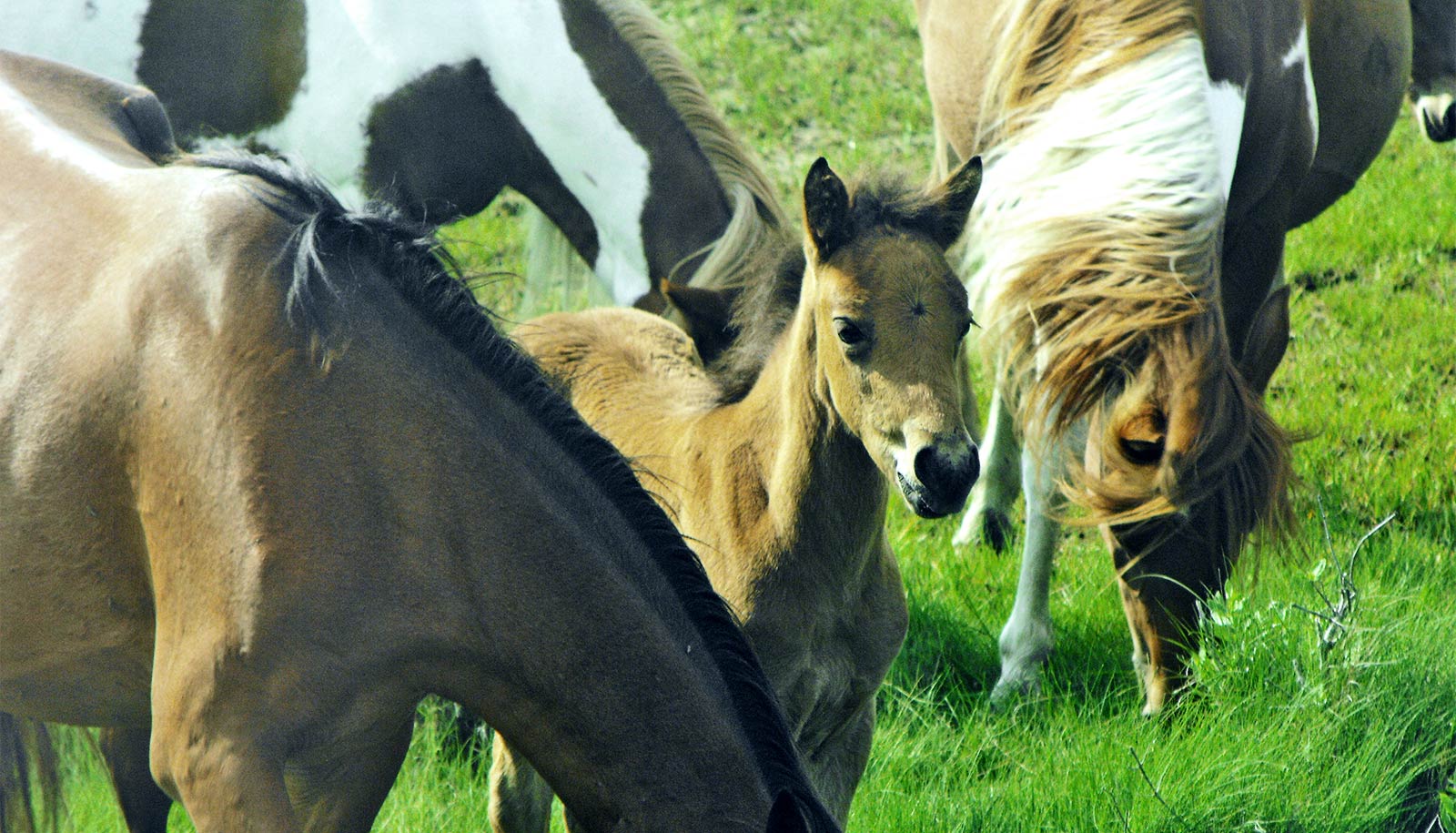For the first time, researchers have identified the cause of a potentially fatal condition in horses that hampers their ability to sweat.
Sweating is a critical tool to keep horses comfortable and healthy, but chronic idiopathic anhidrosis, a dangerous equine condition, can impede their natural cooling mechanism and cause performance and health issues.
The genomic mapping study gave researchers a discovery-based approach to attacking this disease, pushing aside prior assumptions about the disease’s causes. The researchers used genetic markers like signposts, looking for the common genomic markers found in horses that had chronic idiopathic anhidrosis disease. These genetic signposts pointed to a defective potassium transporter that likely hinders sweat function.
“Now that we know which biological pathways cause the condition, we hope to design specific strategies to intervene,” says Samantha Brooks, associate professor of equine physiology at the University of Florida Institute of Food and Agricultural Sciences. “We found that this disease has similarities to cystic fibrosis which has many drug treatments available and in development. Knowing this, we can start to consider ways to treat these horses that suffer from this condition, helping them sweat more normally over longer periods of time.”
Genetic mutations leading to cystic fibrosis also impact ion channels and gave researchers some clues as to how this particular defective potassium transporter might work. Additional research is needed to fully understand, but researchers found a change in the protein that alters when this ion transporter turns on and off. The stress of the sweat gland attempting to function with this faulty transporter likely destroys the ability to sweat over time.
“Using histology, the study of the structure of the tissues, previous work found that the sweat glands become damaged after horses live with chronic idiopathic anhidrosis over long periods of time,” Brooks says. “That is why we have not been successful in reversing the disease and restoring sweat function. Trying to sweat without a functional ion transporter could be the cause of the damage to the cells in the sweat gland. We may not be able to reverse that.”
Having chronic idiopathic anhidrosis is like driving a car on a flat tire, Brooks says. Over time, a horse living with this disease experiences impacts to their overall health beyond the inability to sweat. Living with the condition becomes a quality-of-life concern and unlike other kinds of anhidrosis, chronic idiopathic anhidrosis cannot be solved quickly or cured.
“The saddest part about this disease is that we do not have any specific way to treat the condition right now,” Brooks says. “We can see what is happening and try to address the symptoms but because we do not know exactly what is causing it, we cannot attack the disease. So far, no supplements or medications have been tested and proven to work in a scientific study.”
Most chronic idiopathic anhidrosis horses sweat normally when they are young, but their cells accumulate damage over time, especially in extreme environments like Florida. Older horses experience more severe clinical signs such as critical hyperthermia as they lose more sweat gland function over time.
“We also do not understand the severity aspect,” says Laura Patterson Rosa, animal science graduate student and lead author of the study in the Journal of Investigative Dermatology. “We don’t understand why some horses have it worse than others. Even if it is chronic, the severity differs.”
In their study, scientists were surprised to find the genetic marker that causes chronic idiopathic anhidrosis is a common marker, particularly in sport-type horses like quarter horses and thoroughbreds.
“I think there are a lot of horses out there struggling to live with the early stages of this disease, but owners and caretakers are just not aware of it,” Brooks says. “Long periods of hot humid weather here in the southeastern US aggravate the condition, increasing the chances an owner will notice the problem, but it can be just as much of an issue for horses in more northern locations. You may not think of places up north as having a hot summer that would make it hard for these horses to live, but if a horse has chronic idiopathic anhidrosis it might just take a single day in the 90s to trigger an episode of overheating. That can be very startling to their caretakers, and miserable for the horses. Especially if they live in a climate where those hot days are rare.”
The first signs of an insufficient sweat response and poor cooling are often a decrease in performance of the horse. They may get more tired during exercise, and although they still have some ability to sweat, it is often difficult for caretakers to accurately assess the volume of sweat they are producing. Over time as their ability to sweat decreases, their coats become dry and during overheating episodes it becomes more noticeable. Another side effect includes skin flakiness, rashes and an overall poor hair coat since the sweat glands are no longer distributing healthy oils to the skin.
“If your horse is one of the 2% affected by this disease, this diagnosis can be an absolute disaster,” Brooks says. “Still, I think a lot of these horses are probably out there doing the best they can. They may have slightly decreased performance at first or become a bit lazy in the summer. They are often confused for horses that have allergies, asthma, or a respiratory infection because they pant to cool themselves. At first glance, they look as if they are struggling to breathe, but really, they are struggling to cool themselves.”
Horse owners who suspect their horse has chronic idiopathic anhidrosis should regularly take the animal’s temperature and consult their veterinarian. It may appear that the horse has a fever, but in reality, their basal body temperature is elevated during hot times of day because they cannot regulate it on their own through sweating. Taking their temperature regularly can be a critical component for managing this disease and can help horse owners monitor how well efforts to help keep their horse cool are working and is an important weapon to attack this disease.
“This is a very dangerous disease,” Brooks says. “We often see sweating as a nuisance, but we forget that hyperthermia can be a very life-threatening emergency. This is the time of year, when temperatures start to rise, it is important to revisit this idea and increase awareness among horse owners and caretakers about the condition.”
Horses that have not previously struggled to stay cool and perform may still have issues in the future. As the disease progresses each year and the climate continues to warm, chronic idiopathic anhidrosis is a condition that could be diagnosed more often and become worse for those horses already affected with the disease.
Looking ahead, the research team would like to launch a new project, using samples from horses with and without the disease to measure how much of this disease is due to changes in the function of this particular potassium transfer problem compared to other factors, like the environment. Developing therapies to treat or cure chronic idiopathic anhidrosis and tests to detect a propensity for the condition are future goals as well.
“In our first study we went out and found horses with chronic idiopathic anhidrosis so we would love to measure how much of this disease is due to the potassium transporter and how many horses carry this variant,” Brooks says. “The next step, in collaboration with our colleagues at the UF college of veterinary medicine and pharmacy, will be to see if we can find a compound developed for humans that alters potassium transfer, potentially offsetting the genetic factors contributing to chronic idiopathic anhidrosis in the horse, and administrable in a way that is feasible and economical in such a large animal.”
“Through directed genomic selection, we can eliminate chronic idiopathic anhidrosis from the horse population,” Rosa says. “But that will take time and further research.”
Source: University of Florida



